Learn how to make sushi rice perfectly every time with step-by-step pictures and a video tutorial. All you need are simple ingredients such as rice vinegar, sugar, salt, and kombu. Once you master the secret of making the sushi rice, you will be ready to dish up all kinds of mouth-watering sushi recipes!
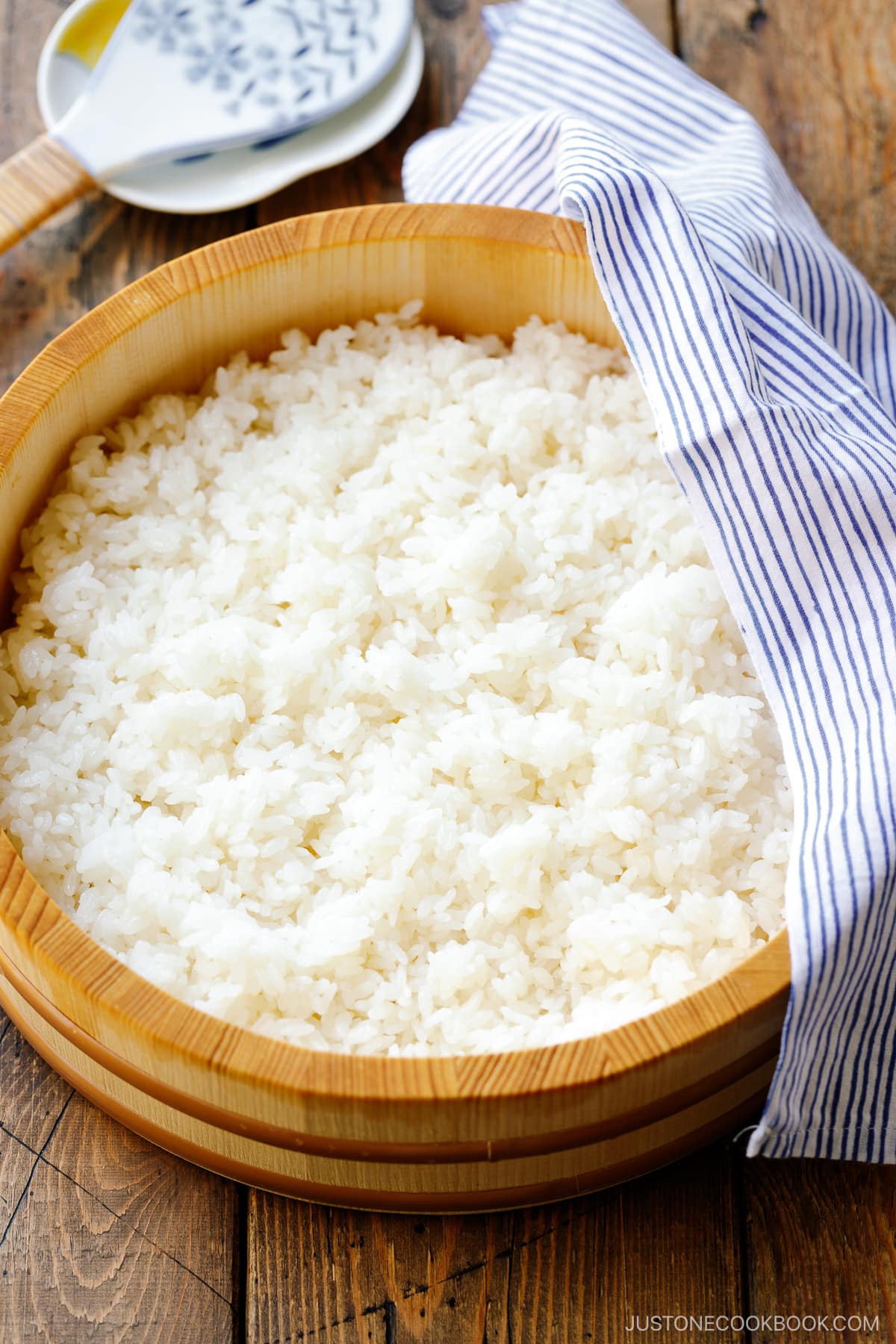
Perfectly cooked Sushi Rice (酢飯) is fundamental in making any form of sushi. Indeed, the best sushi restaurants in Japan pride themselves not only on the freshest fish or variety but on the technique and quality of the sushi rice. Here, I shared my secrets and techniques on how to make sushi rice the authentic way. Follow along, and you’ll be able to make the best sushi rice at home for all kinds of sushi!
Table of Contents


What is Sushi Rice?
Sushi rice is made by cooking Japanese short-grain rice with kombu (kelp), which is then seasoned with a mixture of rice vinegar, sugar, and salt. In Japanese, sushi rice is also known as sushi-meshi (鮨飯), su-meshi (酢飯), or shari (シャリ). We only use this vinegar-flavored rice when making all kinds of sushi.

It’s worth noting that outside of Japan, Japanese short-grain rice is often called “sushi rice” for marketing purposes. In reality, Japanese rice is typically used in everyday meals and less often in sushi recipes.
You may also notice that Japanese short-grain rice has been incorrectly called “sticky rice.” Sticky rice is actually another name for glutinous rice or short-grain Japanese mochigome. We use this type of glutinous rice to make Mochi, Sekihan, and Okowa.
👉🏼 If you are here looking for a recipe to make plain steamed rice, see my post on How to Make Rice.
👉🏼 To brush up on your knowledge, I highly recommend reading “Everything You Need to Know about Japanese Rice” and “Types of Japanese Rice.“
Why Do We Season the Steamed Rice with Vinegar?
This actually goes back to the origin of sushi. The literal meaning of sushi is “sour flavor.” Historically, the way people stored fish was by wrapping it in fermented rice. When they were ready to enjoy the fish, the fermented rice was tossed away.
Sometime between the 1300s and 1500s, the Japanese slowly stopped using fermented rice and instead added vinegar to the rice to further increase its shelf life. The vinegar ended up improving the flavor of the rice so they started eating the fish and the rice together, which evolved to today’s sushi.
These days with refrigeration, there is no longer a spoilage issue with the fish, but the centuries of flavoring the rice with vinegar have become the mainstay.

Where to Buy Japanese Short-Grain Rice
You can find Japanese short-grain rice, commonly labeled as sushi rice, in major grocery stores these days. Some standard, affordable brands like Kokuho Rose and Nishiki are medium-grain rice.
For premium brands, I recommend Tamaki Gold and Tamanishiki Super Premium Short Grain Rice, which are available in Asian grocery stores.

If you’re looking for imported, high-quality rice from Japan, I would recommend the Koshihikari variety, which is available from various brands at Japanese grocery stores. Known for its sweet taste and fragrance, it is the most popular variety in Japan.
My family and I like the Koshihikari rice from Toyama prefecture (see above). Nijiya Market sells it and we think it’s one of the best imported rice available here in the U.S. at this time.
The Right Rice-to-Water Ratio

When cooking rice normally, the Japanese golden ratio for white rice to water is 1 to 1.1 (or 1.2).
However, when making sushi rice (for all kinds of sushi recipes), it is very important to leave room for the sushi vinegar to soak into the cooked rice. For that reason, the amount of water to cook the short-grain rice is slightly moderated.
To make sushi rice, the golden ratio for white rice to water is 1 to 1.
Also, The rice should be cooked slightly harder and the steaming time should be shortened.

How to Make Perfect Sushi Rice
The Ingredients You’ll Need
- Japanese short-grain rice
- Kombu (kelp) – optional, but it infuses your rice with a nice aroma
- Rice vinegar
- Sugar
- Salt
The Cooking Steps
- Cook rice with kombu using your preferred cooking method.
- Make “sushi vinegar” seasoning.
- Transfer cooked rice to a baking sheet lined with parchment paper or a sushi oke or hangiri (traditional method).
- Season the rice with “sushi vinegar.” Then, fluff the rice with a rice paddle using a slicing motion.
- Cover with a damp towel and ready to use.


How Much Rice Do I Need to Cook?
The plastic rice cooker cup that comes with the rice cooker is ¾ cup (180 ml). In Japan, this amount is called ichi go (一合).

- 1 rice cooker cup (180 ml, ¾ cup, 150 g) of uncooked rice
- 2¼ cups or 330 g of cooked rice
- 1 thick sushi rolls
- 2 medium sushi rolls
- 4 thin sushi rolls
- 3 inside-out rolls
- 2¼ cups or 330 g of cooked rice
- 2 rice cooker cups (360 ml, 1½ cups, 300 g) of uncooked rice
- 4⅓ cups, 660 g of cooked rice
- 2 thick sushi rolls
- 4 medium sushi rolls
- 8 thin sushi rolls
- 6 inside-out sushi rolls
- 4⅓ cups, 660 g of cooked rice
- 3 rice cooker cups (540 ml, 2¼ cups, 450 g) of uncooked rice
- 6⅔ cups or 990 g of cooked rice
- 4 thick sushi rolls
- 6 medium sushi rolls
- 12 thin sushi rolls
- 9 inside-out sushi rolls
- 6⅔ cups or 990 g of cooked rice
- 4 rice cooker cups (720 ml, 3 cups, 600 g) of uncooked rice
- 8¾ cups or 1320 g of cooked rice
- 5 thick sushi rolls
- 8 medium sushi rolls
- 16 thin sushi rolls
- 12 inside-out sushi rolls
- 8¾ cups or 1320 g of cooked rice
- 5 rice cooker cups (900 ml, 3¾ cups, 750 g) of uncooked rice
- 11 cups or 1650 g of cooked rice
- 6 thick sushi rolls
- 11 medium sushi rolls
- 20 thin sushi rolls
- 15 inside-out sushi rolls
- 11 cups or 1650 g of cooked rice
Helpful Notes to Remember:
- One thick sushi roll (Futomaki) requires 1⅔ cups (250 g) of sushi rice.
- One medium sushi roll (Chumaki) like Vegetarian Sushi Roll requires 1 cup (150 g) of sushi rice.
- One thin sushi roll (Hosomaki) requires ½ cup (80 g) of sushi rice.
- One inside-out sushi roll (Uramaki) like California Roll requires ¾ cup (110 g) sushi rice.
- One nigiri sushi requires 20 g of sushi rice.

Cooking Tips
- Use Japanese short-grain rice. To achieve an authentic Japanese standard, you want to use only short-grain Japanese rice to make sushi rice. This is because the consistency and flavor of Japanese rice are very different from long-grain rice, jasmine rice, or other types of rice. With a higher content of moisture, Japanese rice is characterized by its unique stickiness and texture, which is attributed to the toothsome bite of authentic sushi. Read more about rice on my pantry page.
- Rinse and soak the rice before cooking. Make sure the rice is washed and rinsed a few times until no more starch comes out from the water. Then let the rice be soaked for at least 20-30 minutes before cooking. This allows the rice grains to yield a better texture.
- Cook the rice with kombu. Kombu (dried kelp) gives a subtle fragrance and umami taste to the sushi rice.
- The rice-to-water ratio is 1:1 (volume). Because we add sushi vinegar to the cooked rice, we use a bit less water than when you cook the rice regularly.
- Make homemade sushi vinegar. Sushi rice is always seasoned with sushi vinegar. It’s made of rice vinegar, sugar, and salt to achieve a balance of sweet, salty, and sour taste. You need to get mild-flavored rice vinegar, not another type of vinegar for this; otherwise, it’s too strong and the flavor is not the same. If you want to save time, you can use a bottle of seasoned vinegar called sushizu (すし酢).
- Transfer cooked rice to a sushi oke (hangiri), a large salad bowl, or a baking sheet lined with parchment paper. You must let the rice cool fast. It’s common to use an electric fan or hand-held fan called uchiwa (うちわ) to cool the rice.
- Add sushi vinegar when the rice is hot. As soon as the rice is taken out of the rice cooker or the cooking pot, you have to season the rice with sushi vinegar.
- Fluff the rice in a slicing motion with a rice paddle. Don’t mix or else sushi rice will end up being mushy or smashed. With proper fanning and slicing, your sushi rice becomes shiny!
- Cover with a damp towel and keep it at room temp until you’re ready to make sushi.
What Does Perfectly Cooked Rice Look Like?
After the rice is steamed, the rice should be shiny and plump. The texture should be fluffy with a firm bite. And each rice grain should be sticky yet retain its shape. Mushy rice means it has too much water or it is overcooked. If the rice is fresh, you will see a nice shiny gloss on the surface of each grain.
Sushi Oke (Hangiri) – A Wooden Tub
The wooden tub that is used to season, mix, and cool sushi rice is called sushi oke (寿司桶) or hangiri (はんぎり). It has straight edges and a flat bottom, which assists in spreading hot rice and allowing it to cool after adding sushi seasoning. The Hinoki cypress absorbs excess moisture.

- 17 inch – MTC Kitchen (Use JOC10 to get 10% off)
- 14 inch – Amazon
- 10 inch – Amazon
Best Way to Store Cooked Rice
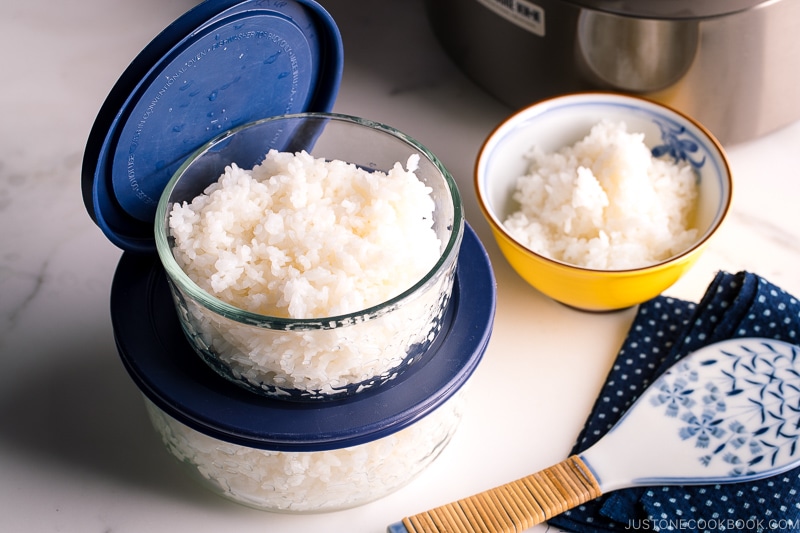
What’s the best method to store cooked sushi rice? Simply freeze the sushi rice in airtight containers and bring it back to room temperature when you need it to make sushi! This is by far the best approach to keeping your sushi rice fresh and moist. Do not refrigerate it!
Other Methods of Cooking Japanese Rice
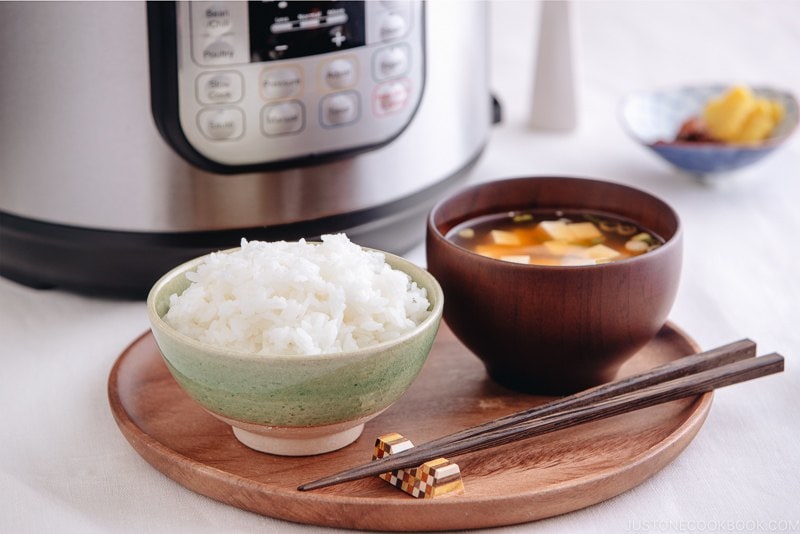

You can cook the rice using a pot over the stove, but the most convenient way is to cook sushi rice using an electric rice cooker. In my Japanese home kitchen, my trusted rice cooker brand is Zojirushi Rice Cooker. Because I cook sushi rice often, this rice cooker has a ‘sushi’ option, which makes it really easy to ensure the rice is cooked perfectly. Here are my recipes for different cooking options.
- How to Cook Rice in a Rice Cooker
- How to Cook Rice in a Pot over the Stovetop
- How to Cook Rice in an Instant Pot
- How to Cook Rice in a Donabe
Delicious Sushi Recipes


Now with perfectly cooked sushi rice, you can make all kinds of sushi recipes! If you are interested in learning more, check out my post Learning at Sushi Skills Seminar in San Francisco.
- California Roll
- Dragon Roll
- Spicy Tuna Roll
- Yellowtail Tuna Roll (Negihama Maki)
- Hosomaki (Thin Sushi Roll)
- Futomaki (Thick Sushi Roll)
- Chirashi Sushi
- Saba Oshizushi (Mackerel Pressed Sushi)
- Inari Sushi
- Temaki Sushi (Hand Roll)
- Temari Sushi
- Mosaic Sushi
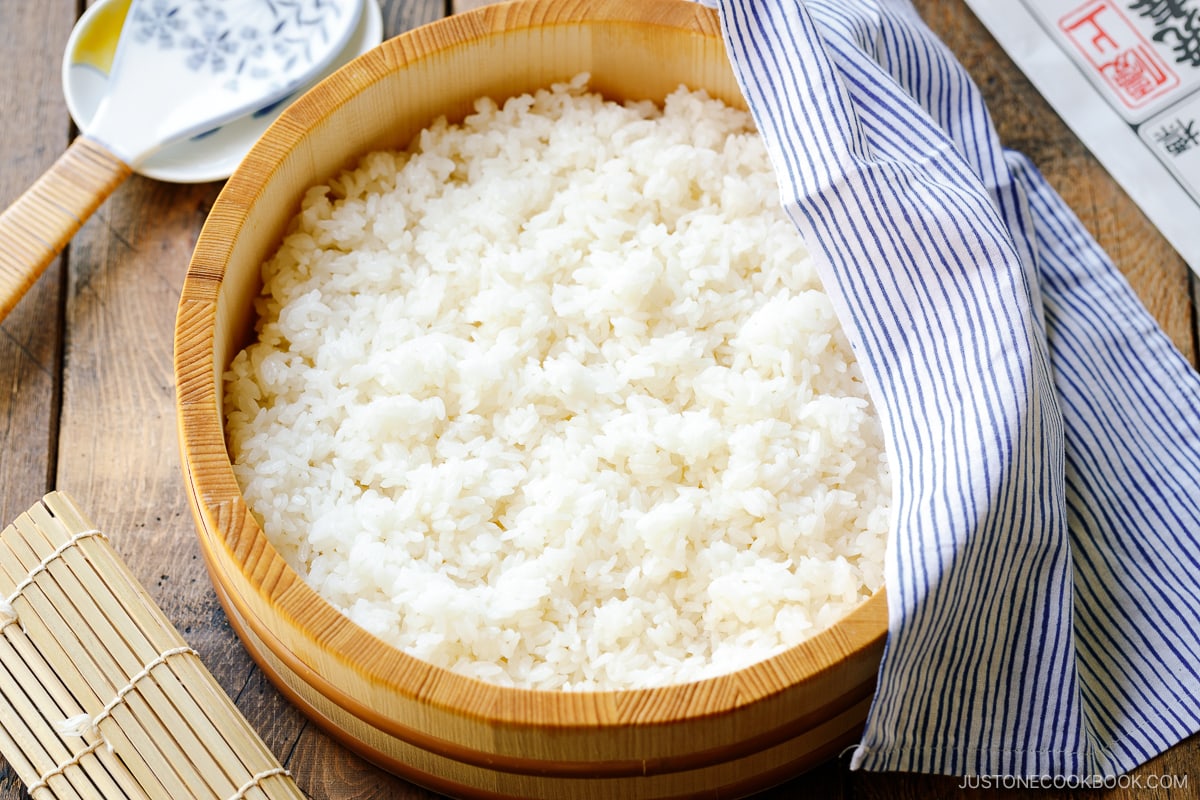
Wish to learn more about Japanese cooking? Sign up for our free newsletter to receive cooking tips & recipe updates! And stay in touch with me on Facebook, Pinterest, YouTube, and Instagram.

How to Make Sushi Rice (for Sushi Recipes)
Video
Ingredients
★ For 5–6 Servings (Makes 6 Medium Sushi Rolls)
- 2¼ cups uncooked Japanese short-grain white rice (3 rice cooker cups; 540 ml; yields 6⅔ cups or 990 g of cooked rice)
- 2¼ cups water (540 ml)
- 1 piece kombu (dried kelp) (5 g per piece; 2 x 2 inches, 5 x 5 cm; optional, for a nice aroma!)
- ⅓ cup seasoned rice vinegar (sushi vinegar) (or make the homemade recipe below)
Homemade Sushi Vinegar (optional; for 5–6 servings above)
- ⅓ cup rice vinegar (unseasoned)
- 3 Tbsp sugar
- 1½ tsp Diamond Crystal kosher salt
★ For 3–4 Servings (Makes 4 Medium Sushi Rolls)
- 1½ cups uncooked Japanese short-grain white rice (2 rice cooker cups; 360 ml; yields 4⅓ cups or 660 g of cooked rice)
- 1½ cups water (360 ml)
- 1 piece kombu (dried kelp) (5 g per piece; 2 x 2 inches, 5 x 5 cm; optional, for a nice aroma!)
- 4 Tbsp seasoned rice vinegar (sushi vinegar) (or make the homemade recipe below)
Homemade Sushi Vinegar (optional; for 3–4 servings above)
- 4 Tbsp rice vinegar (unseasoned)
- 2 Tbsp sugar
- 1 tsp Diamond Crystal kosher salt
Instructions
Before You Start…
- One thick sushi roll (Futomaki) requires 1⅔ cups (250 g) of sushi rice. One medium sushi roll (Chumaki) like Vegetarian Sushi Roll requires 1 cup (150 g) of sushi rice. One thin sushi roll (Hosomaki) requires ½ cup (80 g) of sushi rice. One inside-out sushi roll (Uramaki) like California Roll requires ¾ cup (110 g) sushi rice. One nigiri sushi requires 20 g of sushi rice.

- How to Measure: Overfill a ¾ cup measure or a plastic rice cooker cup with uncooked short-grain white rice and level it off. Put the rice in a large bowl. Repeat until you have the amount needed. Tip: You must use Japanese short-grain white rice or your sushi will fall apart. Please note that 2¼ cups (450 g, 3 rice cooker cups) of uncooked Japanese short-grain rice yield 6⅔ cups (990 g) of cooked rice.

- Gather all the ingredients.

To Wash and Cook the Rice
- Quick Rinse: Add just enough water to submerge all the rice. Then, discard the water immediately. Tip: Rice absorbs water very quickly when you start rinsing, so this step helps remove impurities from the rice and prevent it from absorbing the first few rounds of milky water.

- Wash: Next, use your fingers to gently agitate the wet rice grains in a circular motion for 10-15 seconds. Using very little water allows the grains to rub against each other. It also reduces the absorption of impurities from the milky water.

- Rinse: Add water and immediately discard the cloudy water. Repeat Wash and Rinse (steps 2 and 3) two more times.

- Drain: When the water is almost clear, drain the rice very well. Tip: Use a fine-mesh sieve to drain and shake off any excess water.

- Put the well-drained rice in the inner pot of the rice cooker and add the measured water. If your rice cooker has a Sushi Rice mode, add water up to that line. If not, add water to just under the 3-rice-cooker-cup line for White Rice (for 2¼ US cups of uncooked rice). Tip: For sushi rice, the ratio of short-grain white rice to water is only 1 to 1 by volume—less liquid than for regular steamed rice—to account for the seasoned sushi vinegar that we add to the cooked rice.

- Check the kombu to see if there are any dirt particles. If needed, gently wipe it off with a damp cloth (it‘s a traditional method but these days kombu is pretty clean). Do not wipe off the white powdery substance, which contributes to the umami flavor. NEVER wash the kombu! Now, place the kombu on top of the rice in the rice cooker bowl.

- Soak and Cook: Let the rice soak in the water for 20–30 minutes. Then, start cooking. If you don‘t have a rice cooker, cook the rice in a pot over the stove, Instant Pot, or donabe with the amount of water I specified in this recipe.

To Make the Homemade Sushi Vinegar (Optional)
- If you are not using a store-bought bottle of sushi vinegar (seasoned rice vinegar), follow this step. Combine the rice vinegar, sugar, and salt in a small saucepan.

- Bring it to almost simmer over medium-high heat. Whisk until the sugar is completely dissolved. You can also put the ingredients in a microwave-safe bowl and microwave for 1 minute, or until the sugar is dissolved. Set aside to let it cool.

To Make the Sushi Rice
- If using a wooden sushi oke (also called hangiri), moisten it by running water over it, drain well, and dry it with a clean towel. You can also use a large salad bowl or baking sheet lined with parchment paper. Tip: This wooden tub helps absorb excess moisture while a ceramic bowl can't.

- When the rice is cooked, discard the used kombu (or repurpose it to make simmered kombu).

- Transfer the cooked rice into the sushi oke. Spread out the rice evenly so it will cool faster.

- While it’s hot, pour the sushi vinegar over the rice.

- With a rice paddle, gently “slice” the rice at a 45-degree angle to incorporate the sushi vinegar mixture and separate the chunks of rice. Do not stir or mix the rice because the grains may break and the rice will become mushy. While using this slicing motion, vigorously fan the rice with a paddle fan or another type of fan. Fanning takes away the excess moisture and makes the rice shine.

- Then, gently flip the rice in between slices.

- Repeat this process until the rice is cooled to the temperature of human skin. Your Sushi Rice is now ready to use in your favorite sushi recipes.

To Keep
- Keep the sushi rice covered with a damp towel (or paper towel) for a few hours at room temperature. To keep it for a longer time, see below.

To Store
- Rice gets hard and dry in the refrigerator. My recommendation is to put the sushi rice in an airtight container and store it in the freezer for up to a month. You can defrost it overnight in the fridge, and then microwave to room temperature (not hot). If you really want to refrigerate it, cover the container with a thick kitchen towel, so the rice will stay cool but not become cold.
Nutrition
Editor’s Note: This post was originally published on Aug 18, 2011. It was republished with new images, a new video, and more helpful content on January 19, 2024.
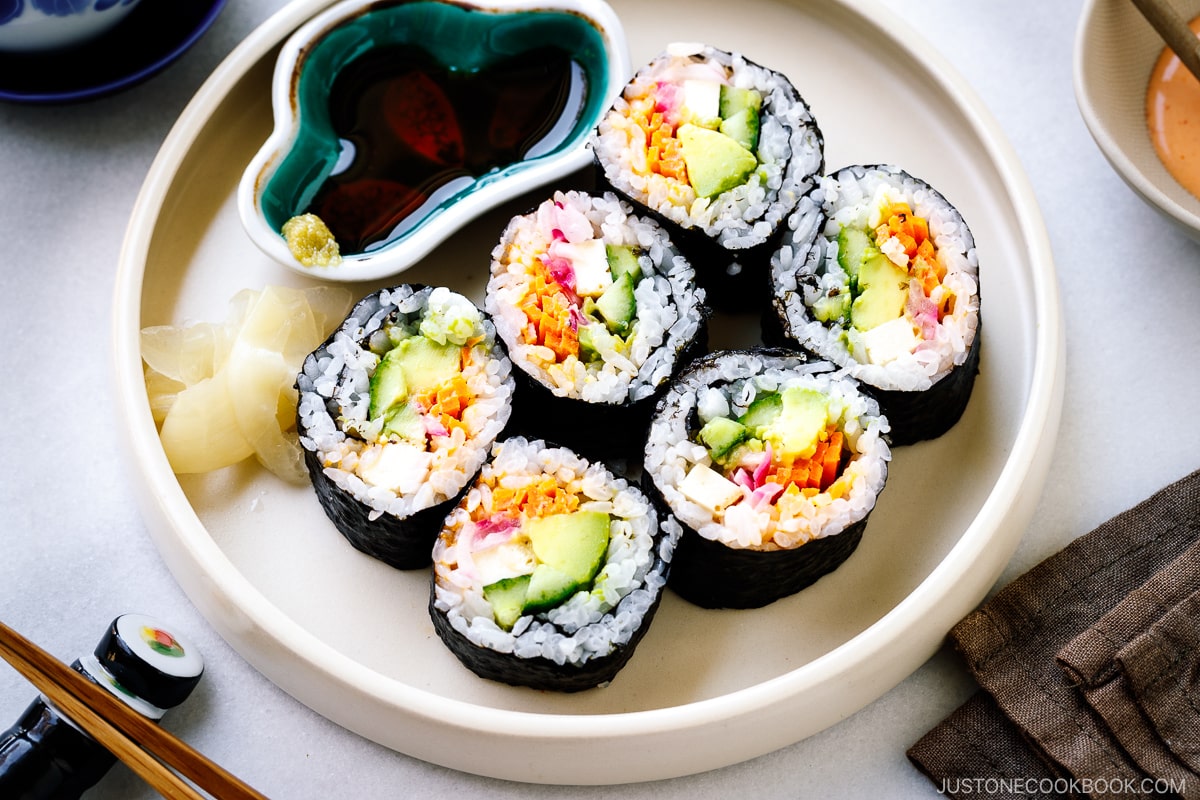



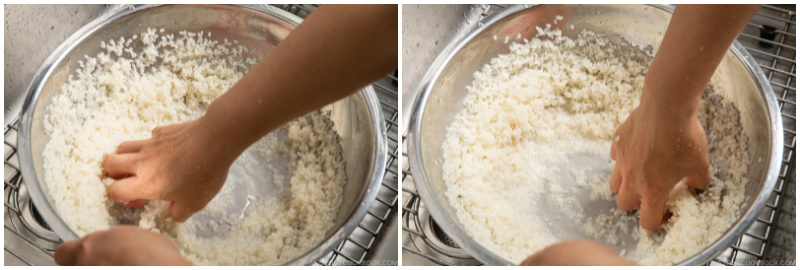



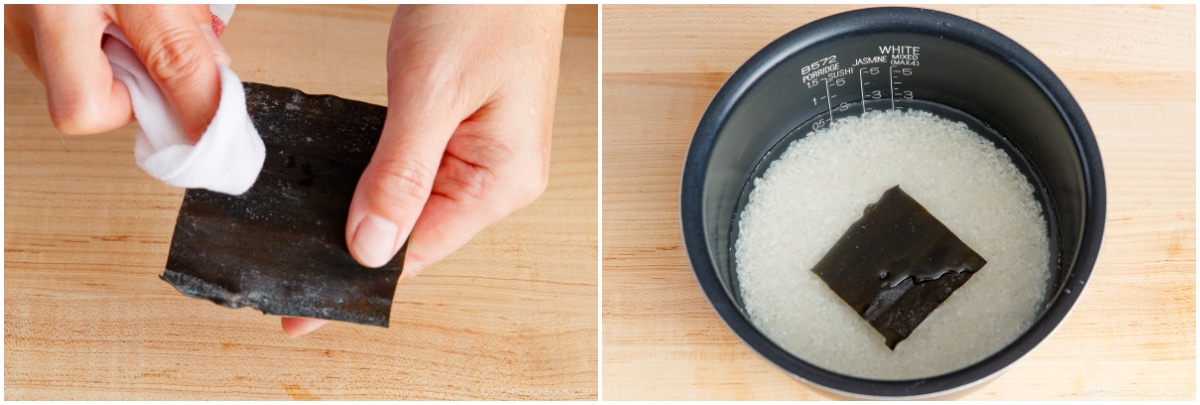






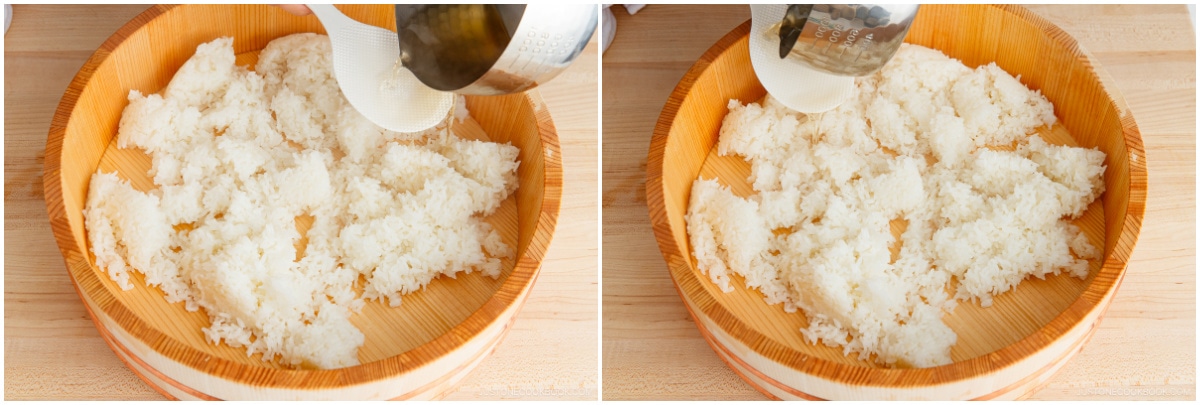















I am thrilled to have found your site and such detailed instructions, along with an interesting culinary history lesson.
Fortunately I realized after my first disastrous barely edible sushi rice mush, that I needed an authentic source. Thank you as well for including the link to your sushi grade fish supplier! It’s not that far from fish deprived Arizona.
Needless to say, I just made myself a near perfect (for an amateur) Alaskan salmon sashimi rice bowl on my very first try, only issue being that I didn’t know about kombu and a need a better fillet knife.
I look forward to exploring your cookbook, I might just be able to find some of the authentic Japanese food my mom made from memory and never wrote down. (I grew up in 60s-70s SF and miss both the Japanese cultural influence and the abundant fresh seafood.)
Hi Andrei! Thank you so much for reading Nami’s post and trying her recipe!
We are so happy to hear that you enjoyed the recipe and everything else we shared. We hope you continue to enjoy exploring our website!
Happy Cooking!
Hello! I saw brown short grain rice at the local japanese market and I wonder if you’ve ever tried making sushi with it? Does it cook similarly? Do you have any favorite brands?
Hi Lindsay! Thank you so much for taking the time to read Nami’s post and try her recipe.
Brown short-grain rice does not have a sticky texture and will be difficult to work with when making Sushi, particularly Nigiri Sushi. This is our recommended brand that is available in the United States.
https://www.amazon.com/dp/B002WFZC6I?linkCode=ssc&tag=onamzjusoneco-20&creativeASIN=B002WFZC6I&asc_item-id=amzn1.ideas.1PXG97D0CRXL8&ref_=aip_sf_list_spv_ons_d_asin
We hope this helps!
Instead of covering the bowl with a damp towel, could we cover with saran wrap?
Hi hmucha! Thank you for reading Nami’s post and trying her recipe!
Yes, you most certainly can. However, the moisture in the rice evaporates and may leave condensation on the plastic wrap.
We hope this helps!
out of curiosity, could i reduce the salt? just a bit? if so, how much do you think is okay?
Hi sayo, Thank you for reading Nami’s post and trying her recipe!
Yes, you may reduce or skip the salt if you prefer.
We hope you enjoy Sushi Rice.
Hi, I’m a fan of your website and have tried many of your recipes with success. I’m keen to try cooking rice in the rice cooker. Just a question with regards to putting kombu in the rice cooker. At what point should I remove the kombu as I understand that it will cause bitterness if left to cook in the water? Is it alright to open the cover of the rice cooker to remove the kombu when it is still in cooking process? Thanks.
Hi Clara! Thank you for your kind feedback! Nami and JOC team are so happy to hear you enjoyed many of the recipes from our site.
You can take out the Kombu when the rice cooker finishes cooking the rice. The rice cooker simmers the rice and Kombu in the perfect condition, so you do not taste the bitterness of the Kombu.
We hope this helps!
Hello, how long can you leave sushi rice on the counter (after following this recipe) before it starts developping bacteria? Thanks!
Hi Magali! Thank you for trying Nami’s recipe!
We can’t tell exactly when the bacteria start developing because it depends on your room temperature and humidity. So, we recommend keeping the sushi rice covered with a damp towel (or paper towel) for no more than a few hours at room temperature. To keep it for a longer time, please see the note on the recipe card.
We hope this helps!
As long as the pH remains between 3.8 and 4.2
How do you have a recipe and not include ratios of vinegar to sugar? It should be really embarrassing.
Hi E Will, Thank you very much for reading Nami’s post and trying her recipe!
The Homemade Sushi Vinegar recipe is on the recipe card.
4 Tbsp rice vinegar (unseasoned)
2 Tbsp sugar
1 tsp kosher salt (Diamond Crystal; use half for table salt)
We hope this helps!
Hi. Thank you for all your wonderful sharing! I have always wondered why can’t we add the vinegar, salt and sugar when (or just before) cooking the rice? Would it be more evenly distributed? Thanks.
Hi May! Thank you very much for reading Nami’s post and trying her recipe!
To achieve a nice texture, the flavor of vinegar, and shiny rice, it’s best to add the Sushi vinegar to warm freshly cooked rice instead of cooking it together.
We hope this helps!
Hi Namiko,
I’m cooking the short grain rice for sushi in a rice cooker and saw above indicated as 2cups grain to 1.5cup of water. Further on, I read it show that due to rice vinegar to be added, the rice to water ratio should be 1:1.
I’m confused now. Appreciate your reply so I can try make sushi tomr ☺️
Thank you vm.
Hi Susan! Thank you very much for reading Nami’s post and trying her recipe!
The rice amount in the recipe card is by rice cooker cup, and it’s not the same as a US cup.
2 rice cooker cups grain = 360 ml = about 1.5 US cup
So the ratio is 1:1.
We hope this helps!🙂
Hi ! I’m cooking my rice in a rice cooker, I use 3 “rice” cups (180 mL) but the 2¼ cups, are they “rice” cups or US cups ?
Hi Tamara! Thank you for trying Nami’s recipe!
The water amount 2¼ cups are US cups (540 ml).
We hope this helps!
What’s the size of your hangiri( the wooden rice tub) ? What size should I get if cooking max 4 rice cups?
Hi Susanna! Thank you very much for trying Nami’s recipe!
We recommend around 10″ hangiri!
Nami uses 10″ hangiri for her family of 4, and it fit 3~5 cup of uncooked rice.
We hope this helps!
This is great! My local Asian grocery store sells tuna and salmon for sashimi for around $18 to $19 a pound. Now I make my own nigiri. It’s a lot cheaper than buying sushi at a restaurant and it tastes great!
Hi Steven! Awesome! We are so glad to hear this recipe worked out well for you!
Thank you very much for trying Nami’s recipe.
I was sent a gift basket of sushi vinegar, mirin and Japanese rice and soy.
May I know if there’s any difference between your version of rice vinegar and this sushi vinegar?
Hi Jessica! Thank you very much for reading Nami’s post!
Sushi vinegar is premixed vinegar that tastes similar to Nami’s version (recipe). Some brand’s Sushi vinegar contains other ingredients, and it is often more vinegary taste or saltier. However, you can adjust the taste to your liking by adding more sugar or rice vinegar.
We hope this helps!
Hello Nami! I adore your site =) I have a question. I’m a became a big fan of amazu vinegar and make it at home. I saw your amazu recipe and it is very similar to sushi rice vinegar (sushi vinegar is just more salty as I see). Amazu:
Homemade Sushi Vinegar (for 3 Rice Cooker Cups)
So my question – can I use amazu vinegar instead of sushi vinegar? =)
Hi Olga! Thank you very much for your kind feedback to Nami! We are glad to hear that you enjoy the JOC site.
Yes, you can use the Amazu vinegar ratio for making Sushi rice.
Some parts of Japan use sweeter Amazu than this recipe too.😊 We hope this helps!
Thank you for quick reply! Much love from Russia =)
My pleasure!
Is there any way to skip sugar in this recipe for someone who doesn’t like sweet – will the vinegar be too overbearing if we only omit sugar? Thanks!
Hi Jenn, Without the sugar, it will be a little overwhelming with vinegar flavor.
How about reducing the sugar amount?
We hope you can adjust the sweetness to your liking.🙂